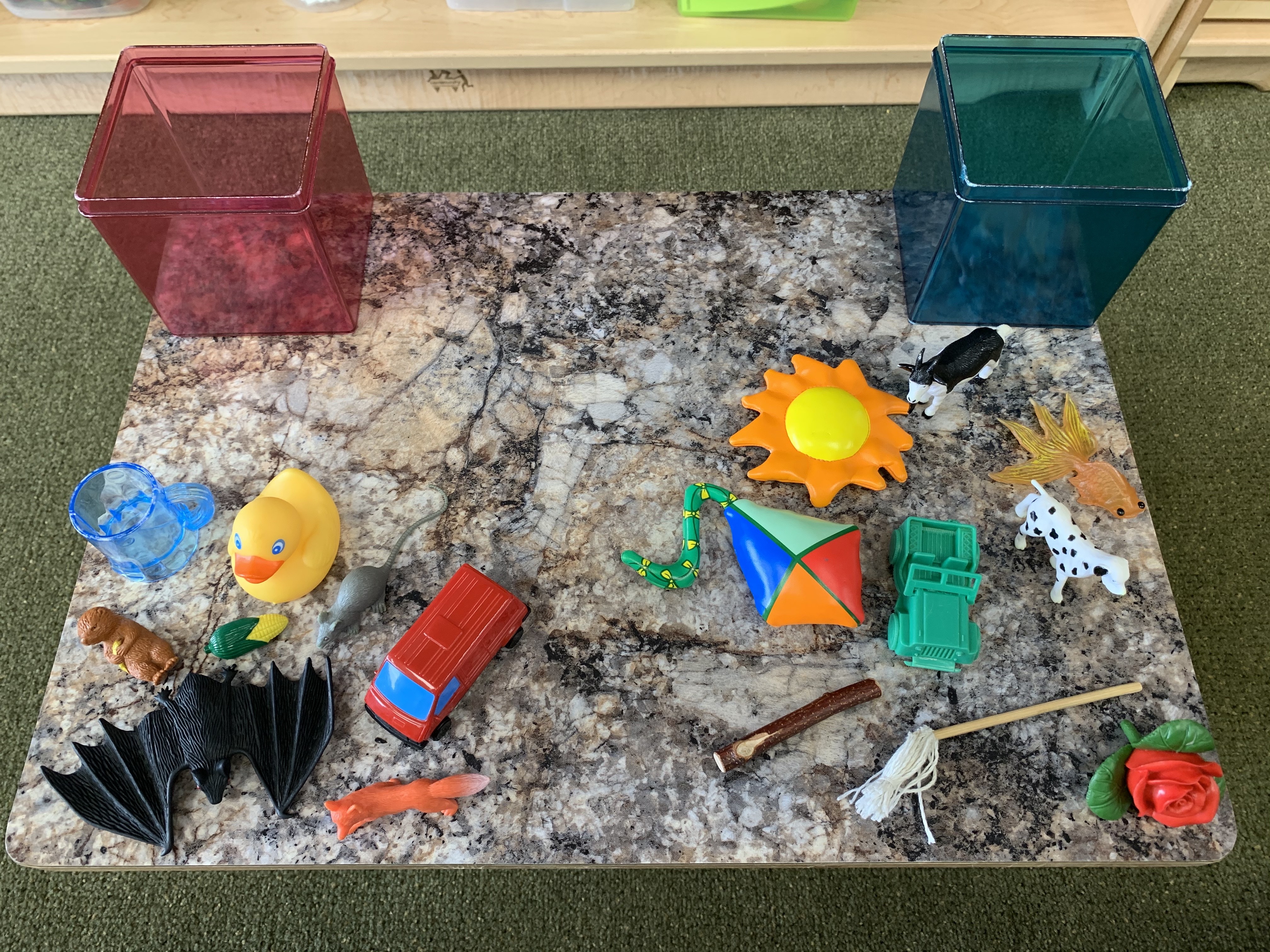I Spy Games
Skills: auditory perception, concept of a word, sounds have an order in words, phonemic awareness, preparation for reading and writing, phoneme isolation

I spy items
Materials:
Objects that use the 40 key sounds / phonemes (see Key Sounds) and contains only 3 of these sounds per object/word.
Presentation I
Beginning Sounds
- Invite a small group of children to join you. Bring the basket of objects from the shelf to a work rug. Sit in a small group. Ask each child to choose one object from the basket and hold it in their hand.
- Name the selected objects with the children. Examples - hat, pig, ship
- With each child holding their object say, “I spy something in Julie’s hand that begins with a /p/.”
- Julie answers, “pig.” The adult repeats the word slowly.
- Repeat steps 3 and 4 with all children. Always repeat the names of the objects.
- Replace their objects with new objects from the basket. Repeat as long as the children show interest.
- As children become more successful increase difficulty and assess for comprehension. Instead of saying, “I spy something in Julie’s hand…” say “I spy something that starts with a /p/.”
- When finished return the work to the shelf.
Presentation II
Ending Sounds
-
Invite a small group of children to join you. Bring the basket of objects from the shelf to a work rug. Sit in a small group. Ask each child to choose one object from the basket and hold it in their hand.
-
Name the selected objects with the children. Examples - can, otter, jeep
-
With each child holding their object say, “I spy something in Fred’s hand that ends with a /p/.”
-
Fred answers “jeep.” The adult repeats the word slowly.
-
Repeat steps 3 and 4 with all children. Always repeat the names of the objects.
-
Replace their objects with new objects from the basket. Repeat as long as the children show interest.
-
As child becomes more successful increase difficulty. Instead of saying, “I spy something in Fred’s hand that ends with /p/.” say “I spy something that ends with /p/.”
-
When finished return the work to the shelf.
Presentation III
Middle Sounds
Note - Once the child is hearing the beginning and ending sounds with ease, introduce the middle sounds. Continue to limit the objects to words containing only 3 phonemes.
-
Bring the basket of objects to the workspace.
-
Take three items out of the basket, name each one. Examples - ant, bat, tub
-
Say to child, “I spy something that begins with /b/ and ends with /t/.” Child responds, “bat.”
-
Adult repeats the words slowly, “Bat. What sound does bat begin with?” Child: “/b/” “What sounds does bat end with?” Child: “/t/” “What do we hear in the middle?” Say the word slowly to help the child find the middle sound. “/a/”
-
As child becomes more successful increase difficulty. “This is a cup. This is a hat. This is a rose. I spy something with the middle sound /u/.”
Presentation IV
Abstraction
In this presentation no objects are used.
-
Choose any word that has 3 sounds or phonemes. The adult must remember that there is often a difference between the number of sounds heard in a word and the number of letters. For example, church. This word has three sounds and six letters. At this time, we are focusing on the child listening to the sounds, not writing the words.
-
The adult would say to the child, “I am thinking of the word chip. What sound do you hear first?” “/ch/” “What sound is in the middle?” “/i/” " What sound is at the end?” “/p/”
Points of Interest:
Hearing the isolated sounds, hearing the separate sounds in a word, finding objects from the clues given, verbalizing the sounds and the words.
Control of Error:
Hearing the sound repeated in the word, limiting the number of choices, us objects containing only three sounds.
Language:
Names of objects, isolated sounds, “I spy…", beginning, middle, ending
Variations:
Use objects in the environment, use pictures of items, use fixed items in boxes for the child to use independently
Extensions:
Use more than 3 sounds in a word, ask the child to pick any word and break it down into component sounds, see how many words the child can think of that begin with or contain any one sound.
Comments:
-
The items in the photo above include: bat, otter, mug, duck, corn, rat, van, fox, sun, dog, fish, kite, jeep, log, goat, mop, rose. I have two “I Spy” boxes containing 8-10 items each.
-
This is a key activity in the development of written language.
-
Presentation I of “I Spy” should be thoroughly covered and mastery achieved before the child proceeds to the Sandpaper Letters.
-
Remember that this activity doesn’t TEACH the sounds. If they child can speak, they know the sounds. With this game we are developing the AWARENESS OF SOUNDS in language.
-
This work is done in parallel to vocabulary development activities.
